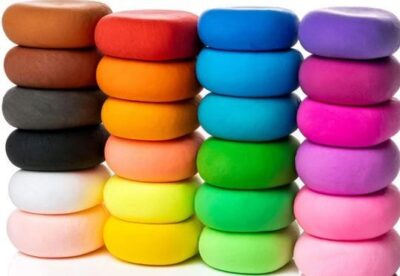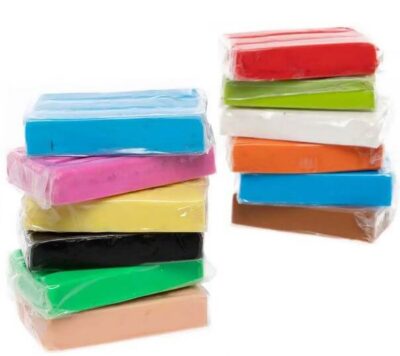A Comprehensive Guide to Air Dry Clay vs. Polymer Clay

In this article, we will look at the differences between Air Dry Clay and Polymer Clay to help you make informed decisions about your creative projects.
When it comes to crafting and sculpting, selecting the appropriate type of clay is crucial. Two popular choices that often perplex beginners are air dry clay and polymer clay – each has unique advantages that could prove valuable when making creative projects.
What is Air Dry Clay?
Air Dry Clay, often called air-dried clay, dries naturally when exposed to air without the need for baking or firing in a kiln.
Air Dry is widely known for being user-friendly and versatile and is composed mostly of clay and water and sometimes additional fibers or materials for reinforcement purposes.
What is Polymer Clay?
Polymer Clay is a synthetic, synthetic clay made of PVC and plasticizer. Unlike Air Dry Clay, however, Polymer Clay requires curing through baking in an oven to dry completely and be usable by artists and crafters alike.
Renowned for its vibrant colors, durability, and ability to precisely hold intricate details, Polymer Clay is beloved among artists and crafters.
Air Dry Clay vs. Polymer Clay
Composition and Nature
Air Dry Clay
As its name implies, air-dry clay naturally dries in response to being exposed to air.
Composed mainly of clay minerals, fine sand, and natural fibers, air-dry clay is non-toxic and easy to work with.
Polymer Clay
Polymer clay is an artificial substance composed of synthetic polyvinyl chloride (PVC) particles.
For proper curing, oven or toaster oven baking must take place to transform its composition and change its chemical makeup chemically.
Workability
Air Dry Clay
Air-dry clay is soft and malleable, making it great for hand molding intricate designs with ease.
Polymer Clay
Polymer clay is firmer and requires conditioning before use, making it perfect for intricate detail work such as maintaining fine lines and textures.
Curing Process
Air Dry Clay
Air-dry clay naturally dries when exposed to air. Drying times vary and could take anywhere between several hours and several days, depending on thickness.
Polymer Clay
Polymer clay must be baked at specific temperatures and for particular times in order to produce durable and long-term finishes. This ensures its permanentity.
Coloring Options
Air Dry Clay
Air dry clay can be painted using acrylics or watercolors once completely dry, lending itself well to various techniques of coloring.
It’s very forgiving of different coloring techniques!
Polymer Clay
Polymer clay comes in many pre-colored options to reduce the need for painting. You can also tint it using special polymer clay pigments.
Durability
Air Dry Clay
Air-dry clay is more fragile, susceptible to cracking or chipping under improper handling, and therefore unsuitable for items requiring frequent handling or moisture exposure.
Polymer Clay
Polymer clay is an exceptional material to create jewelry and figurines with, thanks to its strength once set.
It’s ideal for projects requiring wear resistance, such as figurines and jewelry designs that must withstand everyday use.
Versatility
Air Dry Clay
Due to its non-toxic composition, air-dry clay is an extremely versatile medium for various arts and crafts projects, from papier-mache, pottery, and sculpture to children’s projects.
Polymer Clay
Polymer clay has become increasingly popular as an artistic material for jewelry-making, miniature model-building, and detailed sculpture.
Polymer clay has become a favorite among professionals and hobbyists thanks to its flexibility and ease of use.
Cost
Air Dry Clay
Air-dry clay is less expensive than polymer clay and makes an economical choice for beginners and large projects.
Polymer Clay
Polymer clay tends to be more costly, but its superior performance often justifies this additional cost.
Tools and Accessories
Air Dry Clay
Air-dry clay requires minimal equipment to work effectively – only basic sculpture tools, rolling pins, and water are necessary for its manipulation.
Polymer Clay
Working with polymer clay requires additional tools, including an oven, a pasta machine for conditioning purposes, and special sculpting tools.
Storage
Air Dry Clay
Air-dry clay should be stored in an airtight container to prevent it from drying out before use.
Polymer Clay
Polymer clay should either be kept in its original packaging or wrapped tightly with plastic to avoid drying out and shrinkage.
Environmental Impact
Air Dry Clay
Air-dry clay is more eco-friendly as it doesn’t require high-temperature baking and contains natural materials.
Polymer Clay
Polymer clay production has an increased environmental impact due to the manufacturing process involving synthetic materials and baking.
Safety
Air Dry Clay
Air dry clay is generally considered safe for all ages and doesn’t emit any harmful fumes during use.
Polymer Clay
Polymer clay must be used in an area with adequate ventilation, with proper precautions taken when baking to reduce fume exposure.
Pros and Cons of Air Dry Clay

Pros of Air Dry Clay
Ease of Use: Air Dry Clay is ideal for beginners. No special equipment, such as kilns or ovens, is needed to create beautiful masterpieces using air clay – making this medium accessible to artists of all levels.
Affordability: Clay generally represents the more budget-friendly option compared to Polymer Clay or ceramic clays.
Kid-Friendly: Air Dry Clay is non-toxic and completely safe for children to use, making it the ideal medium for artistic projects with your little ones.
No Curing Required: Air-dry clay differs from Polymer Clay because it dries when exposed to air, saving time and energy during production.
Minimal Shrinkage: Although some shrinkage may occur when drying Air Dry Clay, its shrinkage tends to be significantly less than other clay varieties.
Easy to Paint: Paint, markers, and other coloring mediums adhere readily to it for beautiful and detailed finishes.
Cons of Air Dry Clay
Fragility: Air Dry Clay can become relatively fragile once dried, which makes it less suitable for projects requiring long-term durability such as jewelry or functional pottery pieces.
Limited Working Time: Air Dry Clay quickly begins to harden when exposed to air and can limit the time you have for working on intricate details on larger projects, as it dries quickly.
Cracking: Air Dry Clay can become broken during its drying process. To avoid this happening, we must keep it moist while working with it on an ongoing basis.
Sculpting Limitations: As opposed to oil-based clay or other types of clay, Air Dry Clay may present certain limitations for intricate sculpture and fine details.
Not Suitable for Wet Environments: Air Dry Clay creations should not be exposed for extended periods to moisture exposure as this would compromise them and compromise their integrity.
Limited Color Range: Air Dry Clay can come in various hues, yet its range may not match that of other clay types. Artists may need to mix colors in order to produce certain shades.
Pros and Cons of Polymer Clay

Pros of Polymer Clay
Versatility: Polymer clay is an incredible material to work with. Its uses are limitless, from jewelry and figurines to home decor and miniature sculptures.
Durability: Polymer Clay becomes quite durable after proper curing, making it suitable for objects that must withstand daily wear and tear.
Vibrant Colors: With such an expansive color selection, including translucent options, artists can now craft vibrant and intricate designs without resorting to painting alone.
Long Working Time: Polymer Clay remains flexible until it’s baked, providing artists with plenty of time to create intricate details and perfect their designs.
No Special Equipment: Polymer Clay doesn’t require expensive kilns or special equipment to cure, making this material much less costly than its clay-based alternatives.
Can Mimic Other Materials: Polymer Clay can convincingly imitate various materials such as stone, wood, or metal – further expanding its versatility.
Excellent for Jewelry Making: Polymer Clay’s durability and ability to retain fine details make it a popular choice for creating intricate jewelry.
Cons of Polymer Clay
Requires Baking: Polymer Clay requires baking in an oven at specific temperatures to set and harden, making this material unsuitable for everyone.
Not Kid-Friendly: Due to the need for baking and possible fume emissions during curing, Polymer Clay should only be used by children who are properly supervised.
Toxic Fumes: Polymer Clay may produce toxic fumes when heated. Therefore, adequate ventilation must be maintained when working with this material.
Inflexible After Baking: Once baked, polymer clay cannot be altered further, limiting any attempts at corrections or adjustments after baking has occurred.
More Expensive: Polymer Clay tends to be more costly than Air Dry Clay, making its purchase an important financial consideration for artists on a tight budget.
Not Suitable for Functional Items: Polymer Clay may not be ideal for items such as cups and plates that come into direct contact with food and liquid due to its durability.
Baking Can Affect Colors: Artists should monitor and document the baking results of polymer clay projects to use this knowledge for future projects. The colors may change slightly during baking. Artists are advised to test and record results. Top of Form
FAQs
Can air-dry clay and polymer clay be mixed?
Although possible, mixing these two clay forms is not advised as they have different curing processes and properties that make their combination undesirable.
Are air dry clay projects suitable for outdoor projects?
While air clay can handle some outdoor use, polymer clay would likely last longer and provide better long-term outdoor durability.
Do I require a special oven for baking polymer clay?
Not necessarily; regular home ovens or toaster ovens work just as effectively for this task.
Can children use polymer clay safely?
Yes, with adult supervision required due to baking requirements and possible exposure to fumes.
Which clay should beginners choose for their first experience with clay?
Air dry clay is often recommended due to its ease of use and affordability, making it the best option for first-timers.
Conclusion
Both air-dry clay and polymer clay offer their benefits, with selection being determined by your individual project needs and preferences.
Take into account aspects such as workability, durability, budget, and workability when making your decision – either way you choose, the world of crafting and sculpting is open for exploration and creation!

